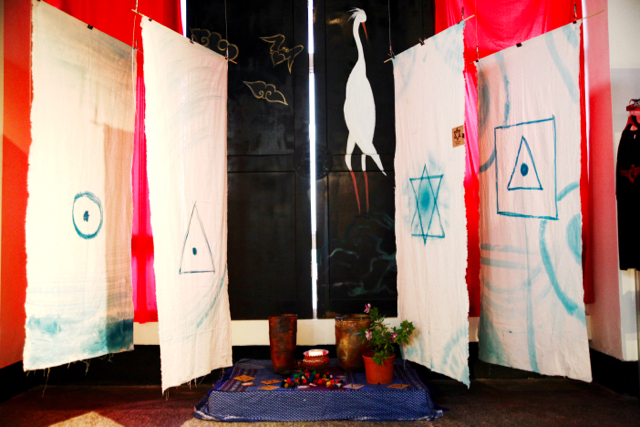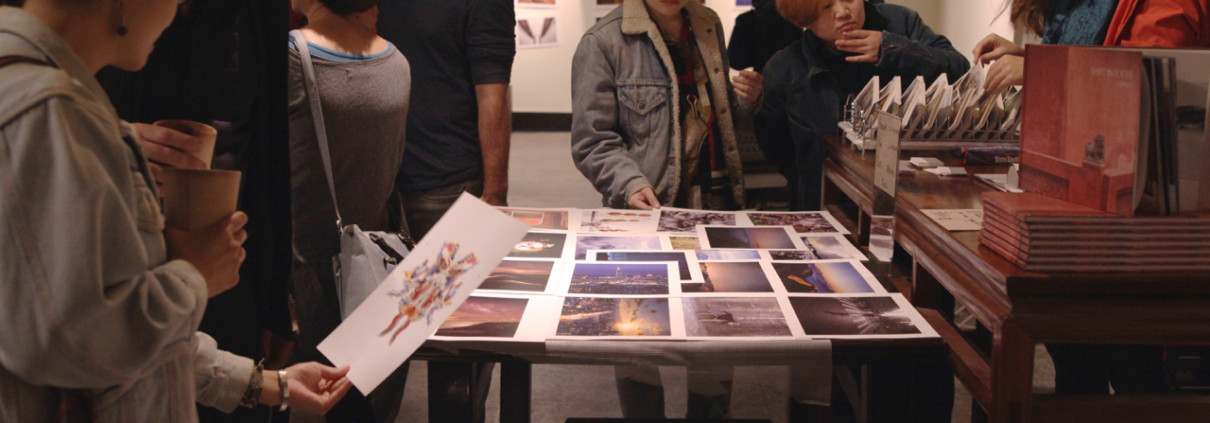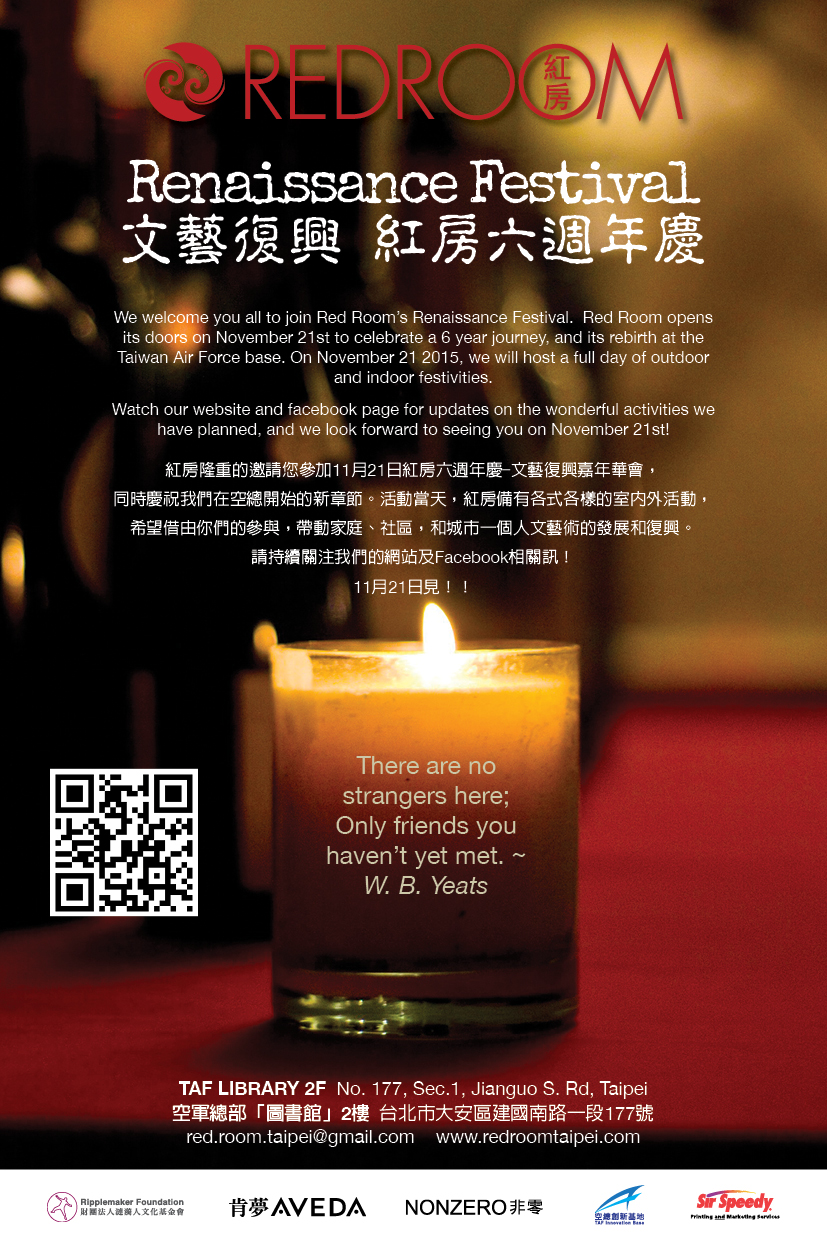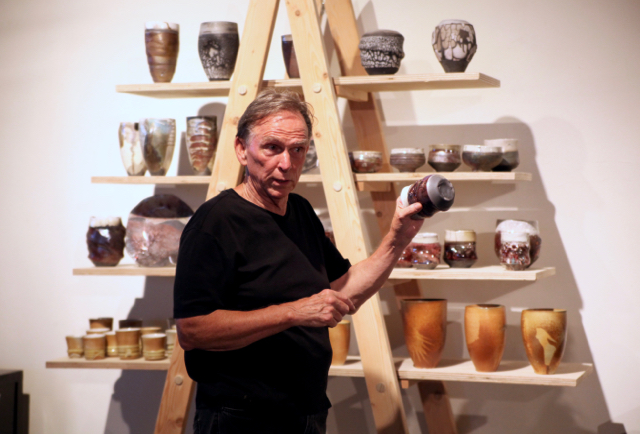Roma Mehta, David Pipkin – VDX
Roma Mehta
I grew up in Calcutta, a densely populated city where the entire spectrum of human experience was in plain sight everywhere you looked. From a very early age i found joy in art and painted every chance i got. It was a way to connect with my inner self and provided an escape from the sadness and misery around me. I could not fix what i saw, but i could create something beautiful.
I decided to study graphic design in college so that i could ensure a living while continuing to paint in my free time. Art and design merged as the years went by and became a way of seeing and understanding the world around me.
My art is a collection of episodes that afford glimpses into moments of clarity and have been essential in my journey.
Portraits, lines and shapes, energy, colours, all blend and become the lens through which I see the world. Art gives me the insights I need to understanding the world I have chosen to live in. India remains the vibrant inspiration, the chaos of my soul and my palette. It disturbs my senses and calls me to become involved. Taiwan brings order to the chaos of things beyond my control. Helps me linger longer in the creative space.
with the first brush stroke
the canvas becomes the master
and leads me through a spirit journey.
i remain receptive as thoughts unscramble and a story unfolds on a living canvas.
inspired by the energy of india,
the spirit of taiwan,
the beauty of our planet,
the embrace of its people.
Artist Bio:
Roma Mehta is originally from India. A graphic designer, an artist, and a committed community member, she has made Taiwan her home since 1987.
Conversations with Artists: Alex Houghton
You said you were a third culture kid, growing up in Taiwan, Hong Kong and Australia. Why did you grow up in so many different countries? How would you say that shaped you?
My father is an Engineer and a specialist in trains. Hong Kong MTR to Taiwan High Speed Rail were some of his projects, so we travelled with the job. It became the normal, new school, new friends, new languages every few years. Everywhere we went there was a time for exploring and learning the culture, and then there was a time to make it home. It really opened my eyes to cultural perspectives, traditions and every day life. I feel like the Koi becoming the Dragon, it was a journey that each place left an influence on me.
So your website says you developed a love of photography when you needed resources to design with. Would you say it evolved from there?
I originally picked up my camera in high school and played with film. I always enjoyed the hands on aspect of it and the meticulous process of developing to printing. When I was eighteen had a lot of time to play with a Sony Cyber Shot 3.2 mega pixel camera and I loved it. I would take my photos and make patterns, brushes and play with blending images. Without realizing it, photoshop became my muse. I went to Kenya and a Doctor gave me his DSLR and say try this. I went nuts and my eyes opened up and realized this was the next level. It was ,and still is, an ongoing process of creating, playing, blending and simplifying. I have chosen to pursue photography and graphic design as my career for 8 years now and the neat thing is, that the photography has taken me far beyond what I expected. It is like a key that has opened many doors and opportunities I never expected.
I’ve noticed you’re original fascination with blending images and transforming them is highlighted in your mini-series, Reflected. Would you care to talk a little bit about the inspiration behind the series?
I love temples and I always felt I couldn’t appreciate the detail of the roofs. I started playing with my zoom lens and trying to capture the detail. I would try find stairs, passage ways, what ever I could do to get higher. I went home and started playing and it struck me that if I reflected my creations on themselves the details were more clear to the viewer. I started playing with the patterns, the colors, the symmetry. Next thing I know it is one of my favorite things to do.
How did the artistic process differ there? Does what you’ve done in the mini-series reflect a satisfaction in a different process or is it simply an extension of what you find interesting about photography?
For me the Reflected Series went back to my Graphic Design Roots. My photography has gone thru phases of heavy editing to simple editing. Reflected allowed me to push the boundary that people became fascinated rather than old conversation of too much or too little photoshop. It’s a different state of mind when I go out to capture stuff for reflected, I search for something that stands out, analyze it, imagine it and then photograph it and edit it.
How has your love of photography changed?
My love of photography is apart of who I am. Every day I am playing with photos, taking photos, researching locations, reading about techniques and having fun with it. It hasn’t changed, it has become more intense and in every aspect of my daily life.
Some people say that art changes the way we see things. How did photography begin changing how you see things?
Playing with perspective, lying on my back in temples, leaning over boats to get the most reflection from the water surface– I love textures, everyday life and the details of makes your local neighbourhood feel so home like. My hope would be that people look at my photos and then go back to there home and see opportunities all round them to photograph. I can’t say it has changed what I see cause a lot of my work was just the way I see it naturally.
Why did you choose to feature Taiwan in your first book?
Taiwan is the longest place I have lived combination of 13 years. This is where I learnt everything, made some of the best friendships, kicked off my working career, fell in love, studied and become who I am today. I wanted to celebrate this beautiful country and show people the diversity of what Taiwan has to offer. I want people not to think of a concrete jungle but rather a wild, intriguing, cultural rich island of treasures. Taiwan to me is the Venice of Asia, I try to explore as much as possible and I feel I am still scratching the surface of possibilities.
I noticed you had different categories: People, animals, mountains, water etc. All in pinyin. How did those categories come about? Why did you choose to write everything in pinyin?
I got organised and laid out all my photos and I saw themes pop out at me, either by colour scheme, lines, and textures and grouped them. By doing that it made the images stronger as a collection to compare and emphasize.
Like my website name is a play on English and Chinese, I wanted my albums to be a play on words.
What do you enjoy shooting most?
Taiwan temples. The detail, history, colours, craftsmanship, the community and peoples all coming for their own reasons. When I enter a temple I imagine how every piece was hand made and put together. The significance of symbols and meanings, the richness of preserving the temple culture and the dedication from the people who maintain it.
What was/is the most challenging part of photography? What advice would you give someone interested in photography?
The challenging part is keeping organised and not ending up with hundreds of photos never edited and sorted. I have tried to slow myself down as we can all go trigger happy especially with digital. The world wants to see photos. so the challenge is getting them off your computer as a nice background in the hands of people to see your work.
Photography is you stopping to capture a moment in time that stood out to you. There are always photos we wish we took, photos that make us want to know how they did that. No matter what celebrate in your own creativity, don’t analyse but rather appreciate. Whatever cameras you have take it out with you. Document what you like, create a memory and have a photo to reflect on it. Art is about expressing yourself so don’t get discouraged; show the world your point of view!
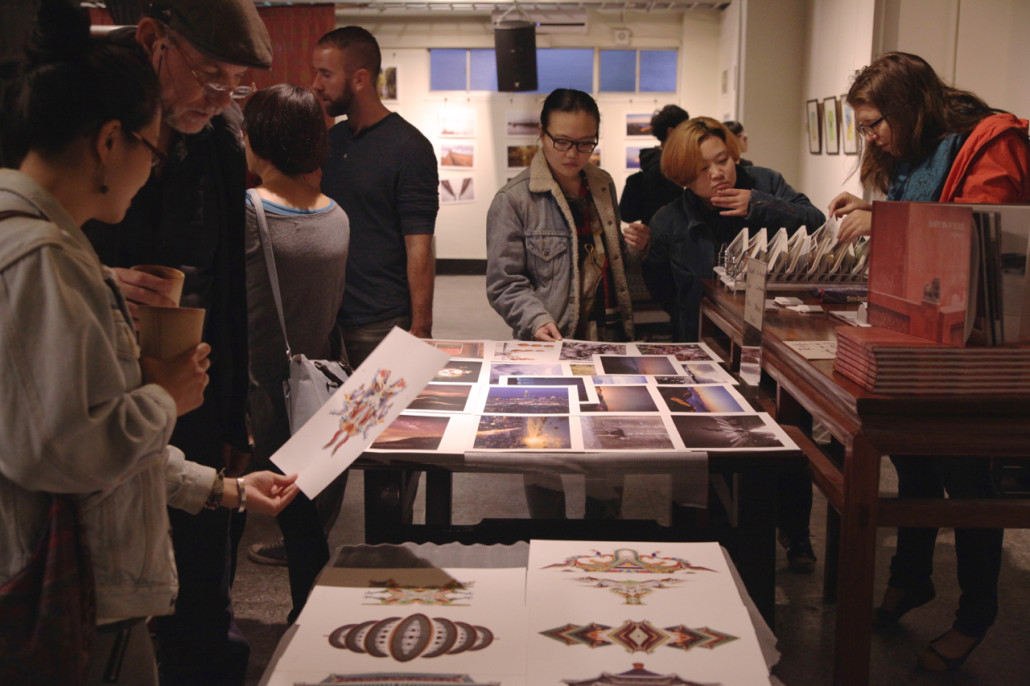
Red Roomers browse through Houghton’s prints and peruse his book at the opening of Red Room’s third Visual Dialogues
When did you first get involved with the Red Room? Why did you choose the Red Room to exhibit your work?
I first came to Red Room 6 years ago when they first opened. I came down with my camera and photographed the layout. 6 years later, 2 of my photos have been used constantly.
Roma [Mehta] has always been a huge role of support for me. She has encouraged me to show the world my photography. She helped me get published in the Centered magazine my “Sausage Man” photo. That encouragement and friend network/support within the Red Room wanted me to do my exhibit with Red Room.
What is it about the Red Room you feel is special?
The Red Room is a space to be creative without borders; it is a place to explore ideas, collaborations, and network with such a chill vibe. Since returning to Taiwan, I just love what Red Room has become and the development over the last 6 years. This is something special that is very unique.
How would you like to see Red Room transform and grow?
I feel Red Room is such a creative hub as long as the people are behind it, we can take it anywhere. It is a place of no boundaries and constant exploration for creativity. I would love to see Red Room get an established long term base so they can set up and invest in it for the long term. I want to see Red Room keep its personal touch while becoming a part of the creative movement growing in Taiwan.
How would you like to see your photography grow? Do you have any goals for your future? Any places you’d like to capture?
I would love to see my photography in collaboration with tourism. It is a dream that my photos could represent someone’s first impression of where they are going. I am going to India for the first time in 2016 and that’s mind blowing for me and can’t wait. There are too many places I want to go to be honest. I lived in Taiwan for twelve years and I feel I haven’t scratched the surface still! I think rather than saying one place, I’ll go anywhere camera in hand. Sometimes the picture you find is a plane ride away or just round the corner.
By Leah List

